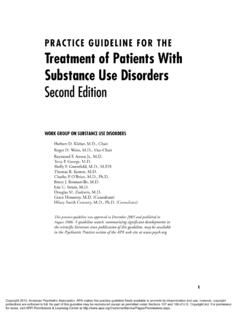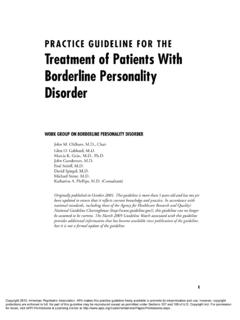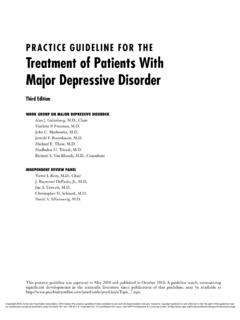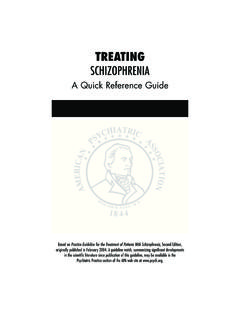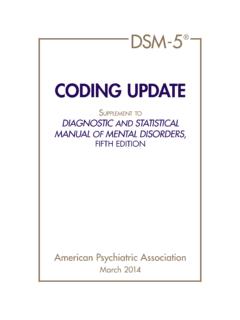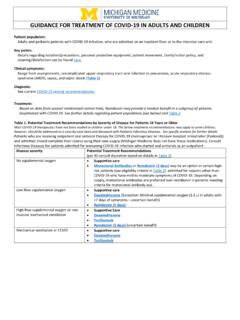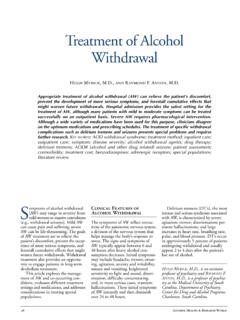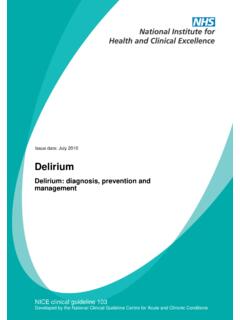Transcription of PRACTICE GUIDELINE FOR THE Treatment of Patients With …
1 PRA CT ICE GU IDEL INE FO R TH E. Treatment of Patients with delirium WORK GROUP ON delirium . Paula Trzepacz, , Chair William Breitbart, John Franklin, James Levenson, D. Richard Martini, Philip Wang, , (Consultant). Originally published in May 1999. This GUIDELINE is more than 5 years old and has not yet been updated to ensure that it reflects current knowledge and PRACTICE . In accordance with national standards, including those of the Agency for Healthcare Research and Quality's National GUIDELINE Clearinghouse ( ), this GUIDELINE can no longer be assumed to be current. The August 2004 GUIDELINE Watch associated with this GUIDELINE provides Additional information that has become available since publication of the GUIDELINE , but it is not a formal update of the GUIDELINE . 1. Copyright 2010, American Psychiatric Association. APA makes this PRACTICE GUIDELINE freely available to promote its dissemination and use; however, copyright protections are enforced in full.
2 No part of this GUIDELINE may be reproduced except as permitted under Sections 107 and 108 of Copyright Act. For permission for reuse, visit APPI Permissions & Licensing Center at AMERICAN PSYCHIATRIC ASSOCIATION. STEERING COMMITTEE ON PRACTICE GUIDELINES. John S. McIntyre, , Chair Sara C. Charles, , Vice-Chair Daniel J. Anzia, Ian A. Cook, Molly T. Finnerty, Bradley R. Johnson, James E. Nininger, Paul Summergrad, Sherwyn M. Woods, , Joel Yager, AREA AND COMPONENT LIAISONS. Robert Pyles, (Area I). C. Deborah Cross, (Area II). Roger Peele, (Area III). Daniel J. Anzia, (Area IV). John P. D. Shemo, (Area V). Lawrence Lurie, (Area VI). R. Dale Walker, (Area VII). Mary Ann Barnovitz, Sheila Hafter Gray, Sunil Saxena, Tina Tonnu, STAFF. Robert Kunkle, , Senior Program Manager Amy B. Albert, , Assistant Project Manager Laura J. Fochtmann, , Medical Editor Claudia Hart, Director, Department of Quality Improvement and Psychiatric Services Darrel A. Regier, , , Director, Division of Research 2 APA PRACTICE Guidelines Copyright 2010, American Psychiatric Association.
3 APA makes this PRACTICE GUIDELINE freely available to promote its dissemination and use; however, copyright protections are enforced in full. No part of this GUIDELINE may be reproduced except as permitted under Sections 107 and 108 of Copyright Act. For permission for reuse, visit APPI Permissions & Licensing Center at CONTENTS. Statement of Intent .. 5. Introduction .. 6. Development Process .. 7. I. Summary of Recommendations.. 9. A. Coding System .. 9. B. General Considerations .. 9. II. Disease Definition, Epidemiology, and Natural History .. 10. A. Definition and Clinical Features .. 10. B. Associated Features .. 12. C. Differential Diagnosis .. 12. D. Prevalence and Course .. 12. E. Causes .. 13. F. Use of Formal Measures .. 15. III. Treatment Principles and Alternatives .. 17. A. Psychiatric Management .. 17. B. Environmental and Supportive Interventions .. 20. C. Somatic Interventions .. 22. IV. Formulation and Implementation of a Treatment Plan.
4 27. A. Psychiatric Management .. 27. B. Choice of Specific Environmental and Supportive Interventions.. 28. C. Choice of Somatic Intervention .. 28. D. Issues of Competency and Consent .. 29. V. Clinical Features Influencing Treatment .. 30. A. Comorbid Psychiatric Disorders .. 30. B. Comorbid General Medical Conditions .. 30. C. Advanced Age .. 30. VI. Reviewers and Reviewing Organizations .. 31. VII. References .. 32. Treatment of Patients with delirium 3. Copyright 2010, American Psychiatric Association. APA makes this PRACTICE GUIDELINE freely available to promote its dissemination and use; however, copyright protections are enforced in full. No part of this GUIDELINE may be reproduced except as permitted under Sections 107 and 108 of Copyright Act. For permission for reuse, visit APPI Permissions & Licensing Center at Copyright 2010, American Psychiatric Association. APA makes this PRACTICE GUIDELINE freely available to promote its dissemination and use; however, copyright protections are enforced in full.
5 No part of this GUIDELINE may be reproduced except as permitted under Sections 107 and 108 of Copyright Act. For permission for reuse, visit APPI Permissions & Licensing Center at STATEMENT OF INTENT. The American Psychiatric Association (APA) PRACTICE Guidelines are not intended to be con- strued or to serve as a standard of medical care. Standards of medical care are determined on the basis of all clinical data available for an individual patient and are subject to change as sci- entific knowledge and technology advance and PRACTICE patterns evolve. These parameters of PRACTICE should be considered guidelines only. Adherence to them will not ensure a successful outcome for every individual, nor should they be interpreted as including all proper methods of care or excluding other acceptable methods of care aimed at the same results. The ultimate judgment regarding a particular clinical procedure or Treatment plan must be made by the psy- chiatrist in light of the clinical data presented by the patient and the diagnostic and Treatment options available.
6 This PRACTICE GUIDELINE has been developed by psychiatrists who are in active clinical prac- tice. In addition, some contributors are primarily involved in research or other academic endeavors. It is possible that through such activities some contributors, including work group members and reviewers, have received income related to treatments discussed in this guide- line. A number of mechanisms are in place to minimize the potential for producing biased recommendations due to conflicts of interest. Work group members are selected on the basis of their expertise and integrity. Any work group member or reviewer who has a potential con- flict of interest that may bias (or appear to bias) his or her work is asked to disclose this to the Steering Committee on PRACTICE Guidelines and the work group. Iterative GUIDELINE drafts are reviewed by the Steering Committee, other experts, allied organizations, APA members, and the APA Assembly and Board of Trustees; substantial revisions address or integrate the com- ments of these multiple reviewers.
7 The development of the APA PRACTICE guidelines is not financially supported by any commercial organization. More detail about mechanisms in place to minimize bias is provided in a document avail- able from the APA Department of Quality Improvement and Psychiatric Services, APA. GUIDELINE Development Process.. This PRACTICE GUIDELINE was approved in December 1998 and published in May 1999. Treatment of Patients with delirium 5. Copyright 2010, American Psychiatric Association. APA makes this PRACTICE GUIDELINE freely available to promote its dissemination and use; however, copyright protections are enforced in full. No part of this GUIDELINE may be reproduced except as permitted under Sections 107 and 108 of Copyright Act. For permission for reuse, visit APPI Permissions & Licensing Center at INTRODUCTION. This PRACTICE GUIDELINE seeks to summarize data regarding the care of Patients with delirium . It begins at the point where the psychiatrist has diagnosed a patient as suffering from delirium according to the DSM-IV criteria for the disorder.
8 The purpose of this GUIDELINE is to assist the psychiatrist in caring for a patient with delirium . Psychiatrists care for Patients with delirium in many different settings and serve a variety of functions. In many cases, a psychiatrist will serve as a consultant to the attending physician and will not have primary responsibility for the patient. This GUIDELINE reviews the Treatment that Patients with delirium may need. The psychiatrist should either provide or advocate for the ap- propriate treatments. In addition, many Patients have comorbid conditions that cannot be de- scribed completely with one DSM diagnostic category. Therefore, the psychiatrist caring for Patients with delirium should consider, but not be limited to, the treatments recommended in this PRACTICE GUIDELINE . To share feedback on this or other published APA PRACTICE guidelines, a form is available at 6 APA PRACTICE Guidelines Copyright 2010, American Psychiatric Association. APA makes this PRACTICE GUIDELINE freely available to promote its dissemination and use; however, copyright protections are enforced in full.
9 No part of this GUIDELINE may be reproduced except as permitted under Sections 107 and 108 of Copyright Act. For permission for reuse, visit APPI Permissions & Licensing Center at DEVELOPMENT PROCESS. This PRACTICE GUIDELINE was developed under the auspices of the Steering Committee on Prac- tice Guidelines. The process is detailed in a document available from the APA Department of Quality Improvement and Psychiatric Services: the APA GUIDELINE Development Process.. Key features of the process include the following: a comprehensive literature review (description follows) and development of evidence tables;. initial drafting by a work group that included psychiatrists with clinical and research expertise in delirium ;. the production of multiple drafts with widespread review, in which 12 organizations and over 83 individuals submitted comments (see Section VI);. approval by the APA Assembly and Board of Trustees; and planned revisions at 3- to 5-year intervals.
10 A computerized search of the relevant literature from MEDLINE, PsycINFO, and EMBASE. was conducted. The first literature search was conducted by searching MEDLINE, using PubMed, for the period 1966 to April 1996 and used the keywords organic mental disorders, psychotic, . delirium , delusions, acute organic brain syndrome, alcohol amnestic disorder, psycho- ses, substance-induced, and intensive care psychosis with haloperidol, droperidol, anti- psychotic agents, physostigmine, tacrine, cholinergic agents, benzodiazepines, thiamine, . folic acid, vitamin b 12, vitamins, morphine, paralysis, electroconvulsive therapy, . risperidone, and neuroleptic malignant syndrome. A total of 954 citations were found. A second search in MEDLINE was completed for the period 1995 to 1998 and used the key words delirium , dementia, amnestic, cognitive disorders, and delusions with halo- peridol, droperidol, antipsychotic agents, physostigmine, tacrine, cholinergic agents, . benzodiazepines, vitamins, morphine, paralysis, electroconvulsive therapy, risperidone.
